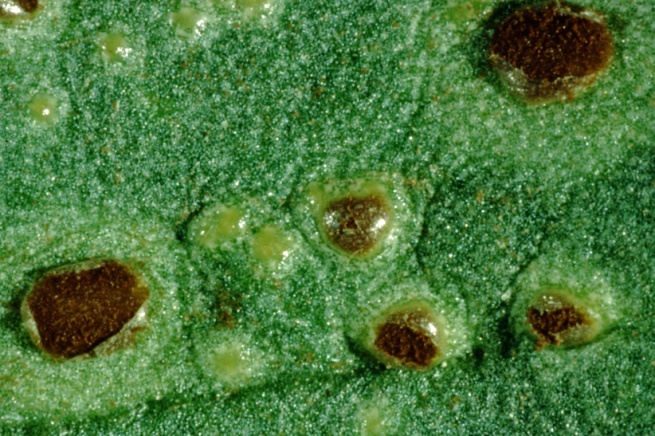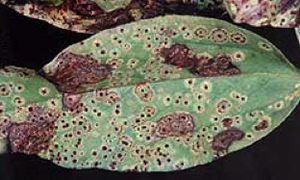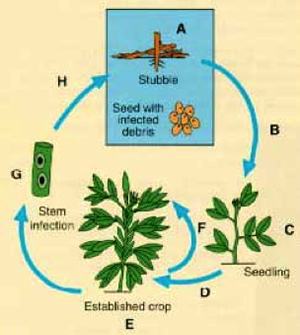Rust of faba bean
Rust, caused by the pathogen Uromyces viciae-fabae, is a serious disease of faba beans grown in Victoria, New South Wales and South Australia.
It can be controlled through the use of resistant varieties and the strategic use of foliar fungicides.
What to look for
On the leaves there are numerous, small, orange-brown pustules, each surrounded by a light yellow halo. As the disease develops, severely infected leaves wither and may fall from the plant. On stems, the rust pustules are similar, but often larger than those on the leaves. Isolated rust pustules may also appear on the pods. Severe infection may cause premature defoliation resulting in reduced seed size.



Disease cycle
The rust fungus survives on stubble and self-sown volunteer bean plants often as teliospores. The teliospores produced can infect volunteer bean plants directly without the need for an alternate host.
Infection of volunteer faba bean plants can be an important factor in the early development of rust epidemics. Rust spores from stubble and volunteers are blown onto new crops by the wind and infect plants.
The leaves, stems, and pods can all be infected. New spores form in rust pustules on infected plants. Secondary spread of the disease occurs when these spores become air-borne and then spread to other plants.
Rust usually occurs late in the growing season during podding, resulting in leaf damage and premature leaf drop. The reduced photosynthetic area results in reduced seed size.
Warm (more than 20C) and humid conditions are conducive to the spread of rust. The incidence and severity of disease can be reduced by growing rust resistant varieties.

Generalised life-cycle of rust disease

- The resting stage (telia) survives in a semi-dormant state over summer in crop residues both in the paddock and on seed.
- Teliospores produced on residues are blown by wind and infect volunteer plants and seedlings.
- Aecia are produced on seedlings.
- Aeciospores spread rust within the crop and to other faba bean crops.
- Uridinia are produced on stems and leaves.
- Urdiniospores spread the disease through the crop canopy.
- Telia form on stems and leaves late in the season.
Image source: Bill MacLeod, Department of Agriculture, Western Australia.
Economic Importance
Rust can be prevalent in all areas where beans are grown, and may significantly reduce yields.
On its own, the disease has caused yield losses of up to 30 per cent, while in combination with chocolate spot yield reductions of over 50 per cent have been reported.
Control measures need to be taken before the disease becomes established in order to minimise crop losses.
Management
The disease can be controlled by using resistant varieties and the strategic use of foliar fungicides. As spores of the fungus can travel long distances to infect a new crop, prevention is difficult.
Paddock selection
- A break of at least three years between faba bean crops is recommended.
- Aim for a separation of 250m from the previous year's faba bean paddock.
- Do not sow adjacent to last year's faba bean stubble.
Variety selection
A number of faba bean varieties are currently available with improved resistance to rust.
See the Victorian crop sowing guide for more information.
Chemical control
Foliar fungicides can be used to control the disease and prevent a rust epidemic developing.
Crops should be monitored closely if warm temperatures (approx 20°C) and very high humidity occur. Successful fungicide application relies on crop monitoring and timeliness of application with the right product effective against rust.
Several products are registered for use against rust, see Pulse seed treatments and foliar fungicides or consult your local agronomist
Further Information
- Pulse Australia
- National Variety Trials
- Faba Bean Southern Region – GrowNotes
- Victorian crop sowing guide
- Pulse disease guide
- Seed health testing in pulse crops
- Download Pulse seed treatments and foliar fungicides
Contact
Dr Joshua Fanning
Pulse Pathologist – Horsham
0419 272 075
Field Crops Pathology
Grains Innovation Park
110 Natimuk Rd
Horsham 3400
03 5450 8301
Or call the Customer Service Centre, 136 186